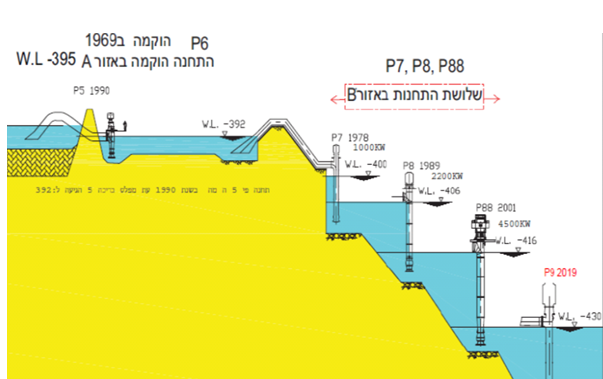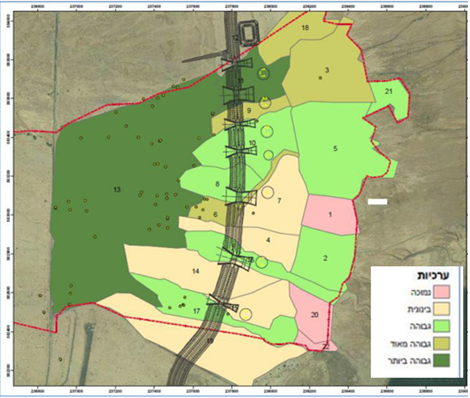Mitigating Disruption
Due to the negative water balance, the water level in the northern basin of the Dead Sea is decreasing at a rate of about 1.1 meters a year. The receding water levels over the years, had so far required ICL to reposition the pumping station towards the north every 10-15 years in last decades (see illustration below), in order to enable the continued existence of the industries of the Dead Sea region, which activities also enable the tourism industry alongside it (more on the subject here). During 2020, ICL is expected to complete construction of the new pumping station – P-9, which will replace the current pumping station P-88. The new P-9 station’s location provides a longer-range solution, for approx. the upcoming 40 years.
The necessity of constructing new infrastructure due to the receding water level in the Dead Sea

The construction of the new pumping station (P-9), approximately 4 km to the north of P-88, requires the extension of the feeder canal accordingly, as well as crossing the Tze’elim stream alluvial fan.
Alluvial fans are geomorphological phenomena of great importance in arid regions. At the shore of the Dead Sea, alluvial fans are created due to a change in the flow channel’s geometry. The stream channel expands upon leaving the He’etekim cliff towards the East, thus decreasing the intensity of the flowing water and alluvium is redeposited at the bottom of the flow channel. Thus, from a deep canyon channel in its mountainous section, in the alluvial fan- the stream becomes a shallow, multi-channeled stream having a braided channel pattern. In addition, the outline of the channels changes from flood to flood, according to the deposited alluvium, in a manner that restrains the force of undermining in the fan’s soft foundations.
The alluvial fan is characterized as an ecosystem wherein a geomorphological system exists, having multiple flow channels whose outlines change from year to year, creating a dynamic and heterogeneous system, both temporally and spatially.
The Tze’elim stream alluvial fan is the largest and most developed of all the surviving fans, and it is therefore very important to preserve it, and thereby protect the biodiversity existing in this habitat.
As aforesaid, the feeder canal crosses the Tze’elim fan, and concerns arose regarding significant harm coming to the fan’s functions. It was therefore necessary to take all possible measures in order to minimize, as much as possible, the effects of crossing the fan. In addition, the feeder channel is exposed to seasonal flash floods in the stream and may be damaged.
A dual need was therefore created, to both protect the canal from flash floods and at the same time allow free flowing water in the flow channels, in order to preserve the stream’s alluvial fan.
As part of the construction of the new pumping station, ICL held extensive and meticulous discussions with environmental authorities and professional entities – particularly the Israel Nature and Parks Authority (INPA), in order to strike the necessary balance between operational needs and the need to minimize the environmental harm to an ecologically sensitive area.
The Tze’elim stream alluvial fan – ecological characteristics of the northern area
The eastern section of the Tze’elim stream alluvial fan spans from route 90 to the mudflats where the Sea has been receding. Alluvial fans and streambeds are habitats wherein creation and destruction processes take place as part of the local life cycle, due to the nature of flood flows. In the Tze’elim alluvial fan in general, and its eastern section in particular, the tempo of these cycles is relatively high, as a result of the decreasing water level of the Dead Sea, which causes phenomena of channeling, undermining and changing flow channels. The ecological system relying on the initial creation biomass develops in accordance with the geomorphological processes. Changes in the pattern on water flow on the surface lead to changes in the spread pattern of flora and the variety of species. This is manifested in the drying up of areas where water used to flow in the past, and the development of flora in other areas, e.g. sinkholes where water is accumulated.
The areas within the alluvial fan serve as habitat for various animals, such as the Egyptian spiny-tailed lizard, the Dorcas gazelle, wolves and striped hyenas. Stream beds and alluvial fans generally serve as habitats of high ecological importance, due to the quantity of vegetation biomass, which serves as foundation to animal activity and due to the variety of ecological niches therein. The Dorcas gazelle is a flagship species, with a population numbering several dozen within the area of the alluvial fan.
Source: “Culvert Array in Tze’elim Stream: Examination of Ecological Aspects”, Maoz Ecology and Environment, March 2016.
The National Infrastructure Plan 35a (NIP 35a) is the plan under which the P-9 pumping station and feeder canal crossing the Tze’elim stream were constructed. The NIP is the expression of the agreements reached between ICL and environmental authorities and organizations. According to these agreements, seven culverts, at various widths (between 18 and 80 meters) were constructed above the excavated canal, in order to allow flood waters to flow through the original flow channel without damaging the feeder canal while maintaining the braided channel fan pattern. On the eastern side of the feeder canal, means will be installed to dampen the flow speed and disperse runoff water in order to prevent channel deepening and undermining upon exit from the culverts. In addition, the culverts serve as an ecological corridor by providing passageways for animals
Location of culverts on background of land-cells – ecological value

In order to ensure no harm is caused to groundwater and to flora in the area, the alluvial fan is constantly monitored through the following means:
- Installation of 10 piezometers to measure the quality and level of the pebble horizontal water;
- Monitoring of flora over time: monitoring acacia trees, flora sectioning, and semiannual mapping by drones for NDVI index (measuring photosynthetic activity) of the entire fan area east of Route 90.
- Monitoring and mapping of subsurface water through magnetic resonance and ground-penetration radar.
- During construction of the feeder canal, close supervision was conducted by the INPA’s infrastructure supervisor, who ensured that the bottom of the feeder canal is above the pebble horizontal and that water permeation is possible to the west and east of the canal.
In case the aforementioned monitoring indicates substantial environmental impact is caused by the feeder canal crossing the stream, ICL will make the necessary modifications in order to minimize the effect on the Tze’elim stream alluvial fan.
